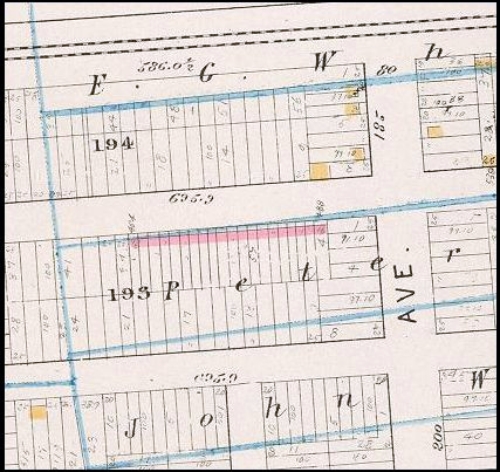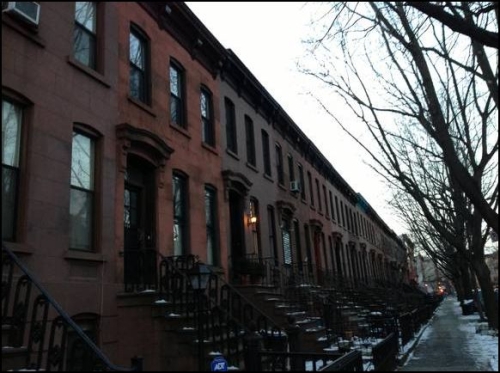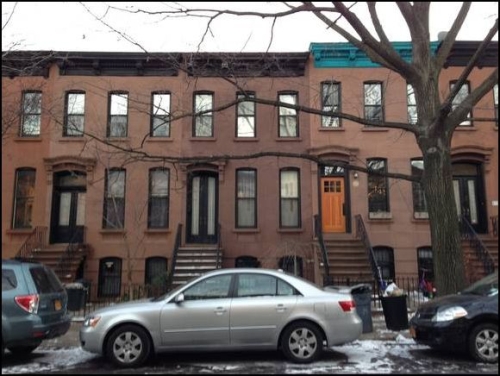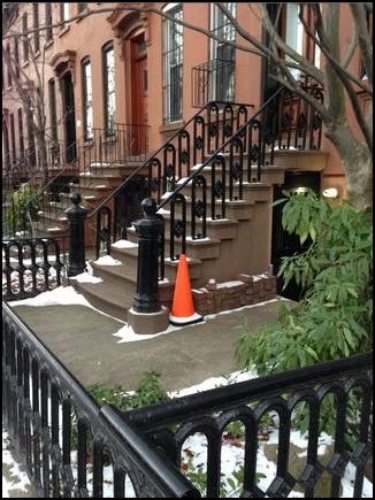Building of the Day: 464-492 16th Street
Excluding the more suburban end, in Flatbush, the area we now call Windsor Terrace was one of the last places around Prospect Park to be developed as a predominantly brownstone neighborhood.

Photo by Brooklynguy
Brooklyn, one building at a time.
Name: Row houses
Address: 464-492 16th Street
Cross Streets: Prospect Park West and 10th Avenue
Neighborhood: Windsor Terrace
Year Built: 1875
Architectural Style: Neo-Grec
Architect: Unknown
Landmarked: No
The construction of Prospect Park began in 1866. At the time, James Stranahan, the “Father of Prospect Park” predicted that property values around the park would rise, and that development of homes would occur on all sides of the park. As we all know, he was right. By 1875, the park was more or less completed, and thousands of people were flocking to the area to enjoy Olmsted & Vaux’s vision of the perfect urban park. They were also buying homes. Excluding the more suburban end, in Flatbush, the area we now call Windsor Terrace was one of the last places around the park to be developed as a predominantly brownstone neighborhood.

The street grid and the lots had been laid out by 1875, and a few wood-framed houses and other buildings dotted the area, but not much was going on except on 16th Street, between 9th (now PPW) and 10th avenues. There, some enterprising developers represented by Jesse S. Carman & Bros, in Manhattan, and J. Burrill & Son, in Brooklyn, were building a long row of twenty townhouses, anticipating the further development of Windsor Terrace.
The developers wanted to get the most bang for their buck, so they decided to build a group of 16-foot-wide houses instead of the more common 18-20-foot-wide homes. This enabled them to squeeze five extra houses in the row, and keep the original lot numbering, by adding “A” houses on five different addresses: 464A, 468A, 472A, 474A and 478A. I used to live in the “A” house, in a very similar, but much smaller grouping in Bedford Stuyvesant, but this is the most I’ve ever seen in one row.

The houses were advertised as being perfect for small families, as they featured “two stories, basement and cellar,” according to the ad in the April 6, 1875, edition of the Brooklyn Eagle. They are early Neo-Grec in design and have simple lines, with the doorways, with their prominent eyebrow pediments supported by incised brownstone brackets. The houses were probably built in groups of five, as evidenced by the slight differences in the rooflines. But they are all the same, with sturdy, attractive cornices. Some houses still have the original ironwork and fencing. They probably sold out in no time.
However, as we see in subsequent Eagle listings, several of the houses went into foreclosure in 1901. 464A, 470, 484 and 486 all went on the auction block that year. They all had different owners. Financial ups and downs always affect the middle class first. And the middle class, ordinary folk who rarely made the paper, were doing well here.

Leon Bliss of 468 was a city inspector. His family had a horrible fright in 1901 when their two year old, Laurence, was picked up by a stranger in the street and carried to a home down the block. The woman who took the boy, said she was a “Good Samaritan” who had rescued the lad. She was very poorly dressed, and was seen by the teachers and students of nearby P.S. 10, walking the boy down the street. The police found her, and arrested her for public intoxication, but the parents refused to press charges, just glad to have their son back.
Children were very active on this block, but not always in a good way. In 1896, the paper reported that Mr. and Mrs. John Bligh, of 470, were celebrating their 10th wedding anniversary with a party. A lot of local neighbors were invited. A couple of months later, the family went away for the weekend, during the 4th of July holidays, and while they were gone, their house was broken into, and items stolen. It turned out that the culprits were a gang of kids from the block. The ringleader was 11 year-old William Schaefer of 472, Thomas Sullivan of 482, who was 12, and his 14-year-old brother John. Another boy, Alexander Thomas, 13, lived around the corner on Windsor Place.

The boys broke in through the kitchen, breaking a padlock, and ransacked the house leaving drawers and belongings strewn all over. When the Blighs returned home, they called the police. It turned out that only a few cheap and random items had been taken, and only ten cents in coin — there was little money in the house. A few days later, a patrolman saw some kids playing on the rail tracks with some cartridges that were among the items on the list of stolen property, and he was able to track the kids down and recover several other items they had stolen.
The boys were arrested and taken to court, where only John Sullivan was not charged, because he never entered the house. All of the boys were released into the custody of their, no doubt, furious parents. Today, the row remains pretty much intact, doors and fencing being the only things sacrificed over the years. This early row represents the first, but certainly not the last, development of Windsor Terrace. GMAP

All photographs by Brooklynguy. I must thank one of our readers, Brooklynguy, for suggesting this entry. He kindly provided photographs, the link to the map, and the original Brooklyn Eagle listing. Many thanks, and I hope this gives you a small insight into the life of your block.
Related Stories
- Suzanne Spellen, aka Montrose Morris, Is Writing Brownstoner’s First Book
- Walkabout: Brooklyn’s Small Parks: Tompkins Park, Part 2
- Fireworks, Victorians and Break-ins: What Independence Day Means to Brooklyn History
Email tips@brownstoner.com with further comments, questions or tips. Follow Brownstoner on Twitter and Instagram, and like us on Facebook.









What's Your Take? Leave a Comment